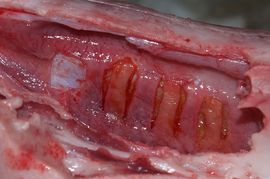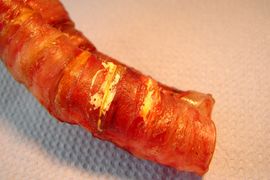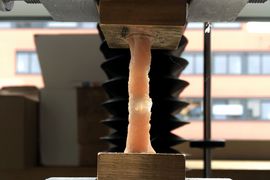The spectrum of potential applications for resorbable adhesives in medicine is very versatile and ranges from the bonding of soft tissue and internal organs, wound closure, tissue defect filling and the bonding of bone fragments in osteosynthesis to the fixation of implants in the body. However, the current use of such adhesives for medical applications is limited to a few specific indications. The reason for this lies in the specific requirements that must be met by a medical adhesive. These include in particular:
- good adhesion to bone and tissue in the presence of tissue fluid
- high adhesive strength (tensile shear strength and compression strength)
- curing within a reasonable time (1 - 5 min)
- no heat development during curing
- lowest possible volume contraction
- high biocompatibility of the adhesive and its degradation products
- fully controllable biodegradability
- sterilizability according to validated methods
- easy handling by medical personnel
Adhesives for soft tissue application in the ear, nose and throat area are based on isocyanate functionalized oligo lactones. The curing is carried out with ambient moisture (tissue fluid) or in a two-component system with polyfunctional alcohols or amines. In vitro cell culture experiments and initial in vivo studies show a very good biocompatibility of the adhesive materials and demonstrate their potential for applications in hard and soft tissue.
Another focus for the development of new adhesives for clinical use is the modification of biopolymers such as gelatine, chitosan, dextran and levan. Promising results have already been obtained in this area. Hydrogel-based adhesives for soft tissue regeneration are accessible, for example, by crosslinking modified biopolymers (chitosan, dextran), as has been investigated in our research department for some time. Amino-group-containing and aldehyde-modified biopolymer derivatives are used as monomers for adhesive resins and crosslinked under appropiate reaction conditions to form amides or azomethine derivatives. These adhesive systems are cytocompatible and show good curing in moist soft tissue.
We also work with functionalized hydroxycarboxylic acid oligomers, which represent a promising class of monomers for adhesives. These monomers are synthesized by a ring-opening polymerization of different lactones in the presence of appropriate hydroxyl-group-containing initiators. In a second step, methacrylate, acrylate or maleate functional groups are introduced to the produced oligomers to produce crosslinkable end groups.
Curable composite adhesives can be obtained by mixing the synthesized adhesive material with different organic (glycine, sorbitol) and inorganic (calcium phosphates, CaCO3, NaCl) fillers. The adhesives cure in the presence of a usual radical initiator (dibenzoyl peroxide/p-bishydroxyethyltoluidine) within 90 - 150 s. Curing under photopolymerization conditions is also possible.
In addition, we have developed adhesives made of renewable raw materials which are suitable for bonding wood and paper. These adhesives are preferable, as they are free of organic solvents and therefore eco-friendly.
We would be pleased to take over your custom synthesis. Detailed information about the synthesizable compounds can be found here.







